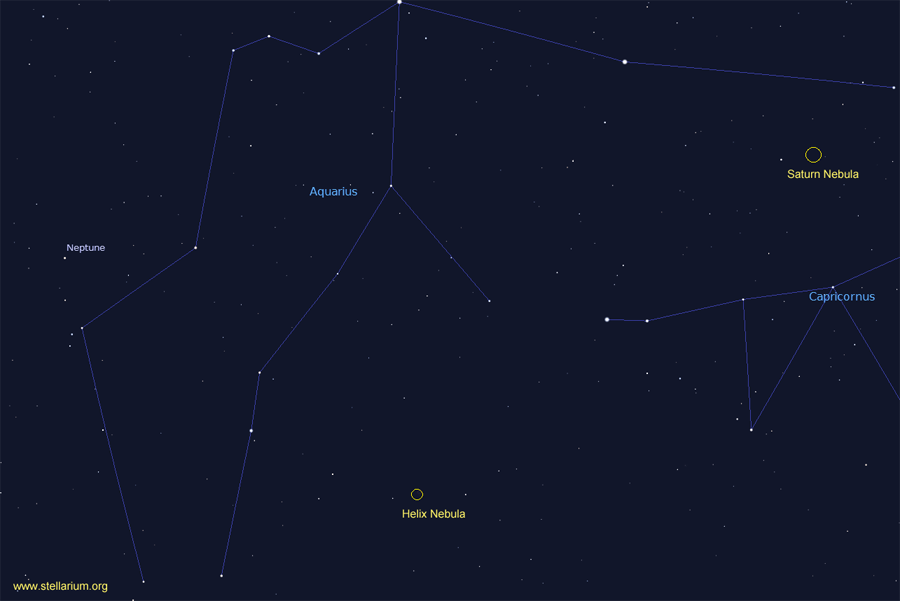Aquarius
The constellation Aquarius is one of the original forty-eight constellations catalogued by Ptolemy in the 2nd century and appears on the ecliptic (zodiac). Also known as the “Water Carrier or Cup Carrier” this constellation is found in the southern part of the sky and measures less than 1,000 square degrees in area. The brighter stars that make up the asterism range in magnitude from 3.1 to 4.5, allowing Aquarius can be seen from the suburbs.
A great object to observe and image is the Helix Nebula. Catalogued as NGC 7293 or Caldwell 63, this magnitude 7.6 planetary nebula measures 14 by 12 arc minutes, roughly half the size of the full moon. At a distance of only 650 lights years, the Hubble Space Telescope had to take multiple images and digitally stitch them together to produce its stunning portrait. When its central star exhausted its fuel some 10,600 years ago, vast amounts of material was cast off into space to form the envelope of material we see today. The Helix is located a third of the way between the stars 59 and 47 Aquarii.
As its name suggests, NGC 7009 dubbed the Saturn Nebula is an irregular planetary with a Saturn like disk. The nebula is located 3,200 light-years from us and glows at magnitude 7. Measuring only .5 by .4 arc minutes, this object might be a bit more difficult to locate. NGC 7009 is situated 1.3 degrees north-west of the star Nu Aquilli.

A challenge object is the globular cluster NGC 7492. This cluster is an outlying globular that resides a staggering 86,000 light-years from us, on the other side of the Milky Way Galaxy. The cluster is thought to be some 200 light-years wide with a very loose association of stars and no dense concentration towards the middle. Even though the overall magnitude is 11.3, individual stars are difficult to resolve with the brightest members being in the 15th magnitude range. Before leaving Aquarius, be sure to look at the planet, Neptune. At magnitude 7.8, it appears as a fuzzy bluish star whose light takes four hours to reach us.
The bright first magnitude star Fomalhaut is the parent to an exoplanet that has been directly imaged by the Hubble Space Telescope The star is about 25 light-years away with its sibling Dagon that orbits the star every 1700 years.
Although Neptune is a telescopic object, there are still two naked-eye planets still available for part of the night. Jupiter is well up after sunset and is not on the meridian. You can still follow its orbiting moons and observe its transits and shadows with the held of the RASC Observers Handbook page 235 and 236. Jupiter sets at 1:45 a.m. local time at the beginning of the month. Saturn with its gorgeous ring system and you can follow the configuration of its five closest moons on page 240 of the Handbook.
This year’s Fall Equinox occurs on the 23rd at 7:50 UT and from that point on, nighttime hours will exceed day time hours. It seems only astronomers are happy with this statement. Another product of the Equinox is the zodiacal lights also known as the ‘false dawn.’ For two weeks after the 26th when the moon is not a hindrance, scan the eastern skies before dawn breaks. This faint glow can appear about 45 degrees above the horizon and is sunlight illuminating the dusty debris of the plane of the solar system.
The full Harvest or Moose Calling Moon occurs on the 14th at 4:33 UT and the new moon (lunation 1197) will occur on the 28th at 18:26 UT.
Until next month, clear skies everyone.
